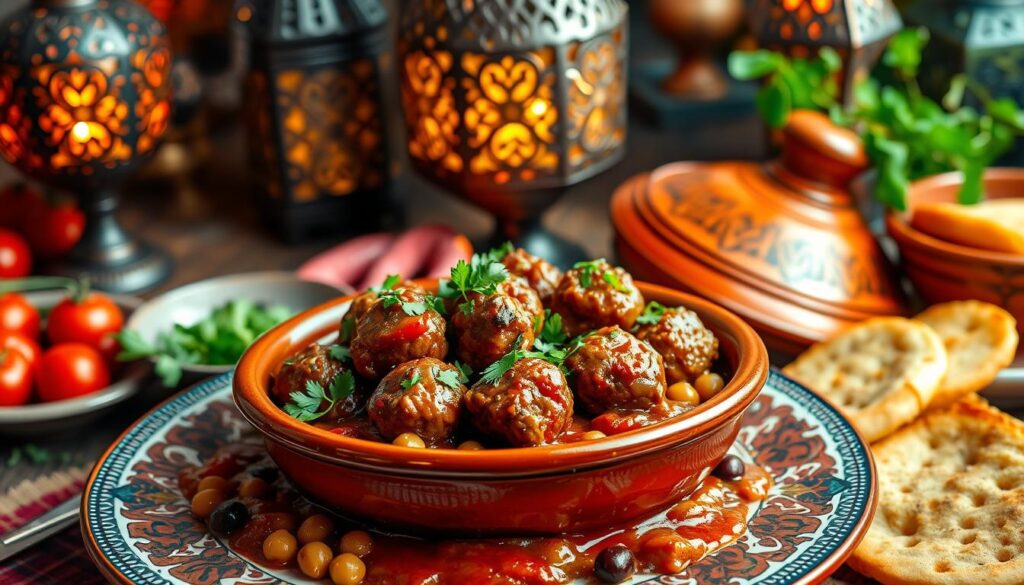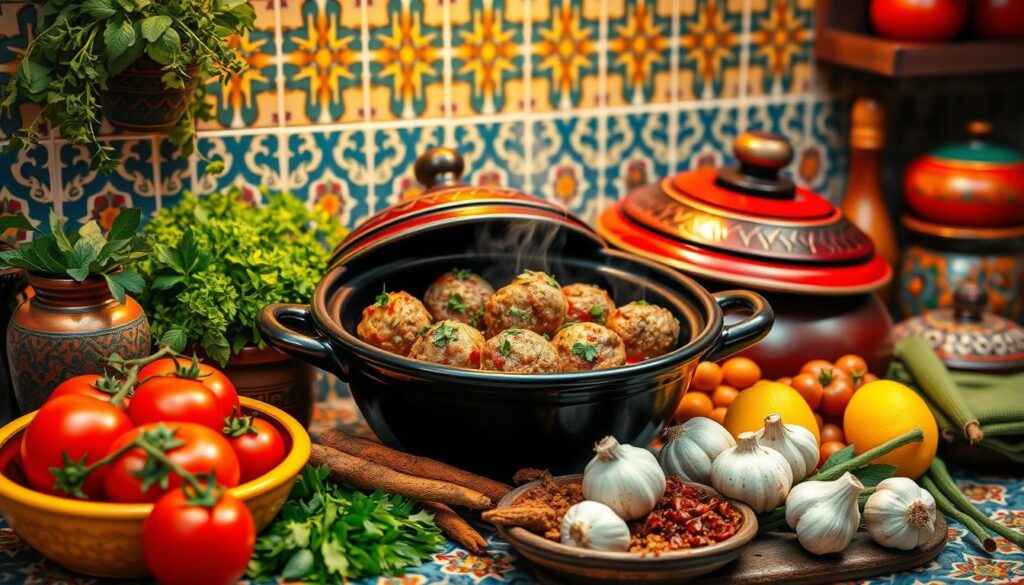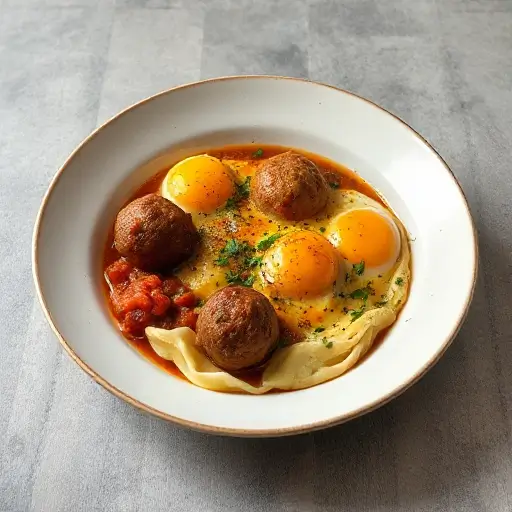I’m excited to share with you the traditional North African dish of moroccan meatballs, also known as meatball tagine. This flavorful and aromatic dish has been a staple of moroccan cuisine for centuries. Its rich history and cultural significance will be explored in this article.
With the help of this guide, you will learn how to make authentic moroccan meatballs. These will transport your taste buds to the vibrant streets of Marrakech, where moroccan tagine is a beloved dish.

In this article, we’ll dive into the world of moroccan meatballs. We’ll explore the secrets of meatball tagine and moroccan tagine. From the essential ingredients to the traditional cooking methods, we’ll cover it all. So, you can create your own delicious moroccan meatballs at home.
Introduction to Moroccan Meatballs
As I share my knowledge of moroccan meatballs with you, I hope you’ll join me on this culinary journey. We’ll discover the rich flavors and aromas of moroccan cuisine, including the popular moroccan tagine and meatball tagine.
Key Takeaways
- Learn how to make authentic moroccan meatballs
- Discover the secrets of meatball tagine and moroccan tagine
- Explore the essential ingredients for moroccan meatballs
- Understand the traditional cooking methods for moroccan tagine
- Get ready to transport your taste buds to the vibrant streets of Marrakech
- Master the art of creating delicious moroccan meatballs at home
The Rich Heritage of Moroccan Meatballs
Exploring Moroccan cooking, I find Moroccan Meatballs fascinating. They come from North African cuisine and are key in arabisk mad, mainly in autumn feasts.
These meatballs hold deep cultural meaning in Morocco. They’re served at big events, showing hospitality and warmth. Over time, the recipe has mixed different cultures, creating a unique taste.
Origins in North African Cuisine
Moroccan Meatballs have a long history, influenced by Arabs, Berbers, and Mediterranean cooking. They’re known for their spices like cumin and coriander, which add to their flavor.
Traditional Significance in Moroccan Culture
In Morocco, food brings people together. At autumn feasts, Moroccan Meatballs are a main dish. Their smell invites everyone to share in the joy of arabisk mad.

Evolution of the Recipe Through Generations
The Moroccan Meatballs recipe has changed over the years. Fresh herbs like parsley and cilantro have become more common, adding a fresh taste. I’m excited to try new versions of this recipe.
Essential Ingredients for Authentic Moroccan Meatballs
To make delicious Moroccan meatballs, you need the right ingredients. The type of ground meat is key. Beef and pork mix gives a richer taste. Onions, garlic, and ginger add depth to the flavor.
Spices are crucial. A mix of cumin, coriander, cinnamon, and paprika is needed. You can find a Moroccan spice blend in a resepi biskut. This makes it easy to get the authentic flavor.
Here are the main ingredients for Moroccan meatballs:
- Ground meat (beef and pork)
- Onions
- Garlic
- Ginger
- Moroccan spice blend (including cumin, coriander, cinnamon, and paprika)
Using these ingredients, you’ll make authentic and tasty Moroccan meatballs.
Quality ingredients and proper preparation are key. With practice, you’ll make unforgettable Moroccan meatballs.
| Ingredient | Quantity |
|---|---|
| Ground meat | 1 pound |
| Onions | 1 medium |
| Garlic | 3 cloves |
| Ginger | 1 inch |
| Moroccan spice blend | 2 tablespoons |
Spices That Make the Magic Happen
Creating an authentic moroccan tagine starts with the right spices. Maggie Beer said, “The key to a great dish is in the layers of flavor.” For moroccan tagine, this means using a mix of traditional spices for a rich taste.
Traditional Moroccan Spice Blend
A traditional moroccan spice blend includes cumin, coriander, cinnamon, and turmeric. You can find these spices at local markets or online. Mixing them together creates a unique and tasty flavor.
Building Layers of Flavor
To add layers of flavor, start by sautéing onions and garlic in oil. Then, add your spice blend and cook for a few minutes. Next, add your protein and vegetables and cook until they’re tender.
Lastly, add some liquid like broth or water. Simmer the dish until the flavors blend together.
Where to Source Authentic Spices
For authentic spices, visit a local market or specialty store. You can also find a variety online, like at Maggie Beer’s store. Choose high-quality spices to enhance your dish’s depth and complexity.
Preparing Your Meatball Tagine Base

To make a tasty meatball tagine, start with a flavorful base. This is key for a october dinner when it’s cooler outside. You’ll want something warm and hearty.
The base of the meatball tagine combines onions, garlic, and tomatoes. You can choose fresh or canned tomatoes. I mix both for a richer taste.
Here are some tips for your meatball tagine base:
- Use top-notch ingredients, like fresh spices and herbs.
- Cook the onions and garlic until they’re soft and smell great.
- Feel free to try different spice and ingredient mixes to find your favorite.
By following these tips and choosing the right ingredients, you’ll make a delicious meatball tagine base. It’s perfect for your october dinner.
Crafting the Perfect Moroccan Meatballs

To make authentic moroccan meatballs, you need the right mixing and shaping. This ensures the perfect texture and flavor. The same goes for arabisk mad, a dish inspired by Moroccan cuisine.
Here are some tips to keep in mind:
- Use a mix of ground meats, like beef and pork, for a richer taste.
- Avoid overmixing the meat to prevent dense meatballs.
- Shape the meatballs by hand for a uniform size and texture.
By following these tips and using the right ingredients, you’ll make delicious moroccan meatballs.
| Meatball Size | Cooking Time |
|---|---|
| Small | 10-12 minutes |
| Medium | 15-18 minutes |
| Large | 20-25 minutes |
Remember, practice makes perfect. Don’t get discouraged if your first batch doesn’t turn out right. Keep trying, and you’ll soon be a pro at making these tasty dishes.
The Art of Tagine Cooking
Exploring moroccan cooking, I find the traditional tagine method fascinating. It needs patience, skill, and practice. A moroccan tagine is a clay pot with a conical lid. It’s made to spread heat evenly and mix flavors perfectly.
Choosing the right tagine is key. You can pick from clay, ceramic, or cast iron. Each has its own traits. The right choice depends on your cooking style and preference. Seasoning your tagine well is important to avoid cracks and ensure even heat.
Here are some tips for mastering tagine cooking:
- Use aromatic spices and herbs for a flavorful broth.
- Add ingredients in the right order for perfect cooking.
- Let the dish simmer slowly to blend flavors.
Moroccan cooking is an art that needs dedication and passion. With time and effort, anyone can become skilled in making delicious moroccan dishes. These dishes will surely impress your loved ones. Whether for a big gathering or a cozy meal, the moroccan tagine is perfect for many tasty meals.
By following these tips and trying out different recipes, you’ll soon master moroccan tagine cooking. So, why not try it and explore the rich flavors and aromas of traditional moroccan cuisine?
| Tagine Type | Material | Characteristics |
|---|---|---|
| Clay Tagine | Clay | Porous, breathable, and excellent heat distribution |
| Ceramic Tagine | Ceramic | Non-porous, easy to clean, and resistant to scratches |
| Cast Iron Tagine | Cast Iron | Durable, excellent heat retention, and versatile |
Sauce and Garnish Combinations
Choosing the right sauce and garnish can transform moroccan meatballs. A classic sauce can take the dish to the next level. A thoughtful garnish adds authenticity. Pairing your meatballs with resepi biskut, a Malaysian cookie, is a great idea.
Try different sauces like tangy tahini or spicy harissa. Add freshness with parsley or lemon juice. For a hearty side, serve with crusty bread or roasted veggies.
Traditional Sauce Variations
Traditional sauces for moroccan meatballs include tomato, bechamel, or pepper sauce. You can mix herbs and spices for a unique flavor. Adding cumin or paprika can give a smoky taste.
Garnishing for Authenticity
Use fresh herbs like parsley or cilantro for authenticity. Sumac or cumin add color and flavor. Serve on lettuce or with roasted veggies for a fancy look.
Serving Suggestions and Side Dishes
There are many ways to serve Moroccan Meatballs. For a real taste of Morocco, try couscous, veggies, and a side of moroccan tagine. This stew is great for a cozy October dinner, warming you up and filling you up.
My moroccan tagine is like a blank canvas. It’s ready for different side dishes to enhance its flavors. Here are some of my top picks:
- Roasted vegetables, such as Brussels sprouts or carrots
- A simple green salad with a light vinaigrette
- Grilled flatbreads, perfect for sopping up the savory sauce
How you present Moroccan Meatballs matters too. Add fresh herbs like parsley or cilantro. Serve in a beautiful tagine dish. This makes the dish feel more special. Whether it’s for a dinner party or a quiet night, these ideas will make your moroccan tagine unforgettable.
With these tips, you’re ready to make a delicious Moroccan Meatball dish. It’ll come with all the trimmings of a traditional moroccan tagine. So, get creative and enjoy sharing this amazing cuisine with loved ones on a cozy October dinner.
| Side Dish | Description |
|---|---|
| Couscous | A traditional North African dish made from steamed semolina flour |
| Roasted Vegetables | A variety of vegetables, such as Brussels sprouts or carrots, roasted to perfection |
| Grilled Flatbreads | Perfect for sopping up the savory sauce of the moroccan tagine |
Making Moroccan Meatballs Ahead: Storage and Reheating
Exploring Moroccan cuisine, I found making meatball tagine ahead saves time. Experts like Maggie Beer share great storage and reheating tips. These are useful for both busy cooks and seasoned chefs.
Let’s talk about storing your meatball tagine. You can refrigerate or freeze it for later. Here are some helpful tips:
- Refrigerate: Store your meatball tagine in an airtight container in the refrigerator for up to 3 days.
- Freeze: Place your meatball tagine in a freezer-safe container or bag and store it in the freezer for up to 3 months.
To reheat, use the oven or stovetop. Maggie Beer suggests reheating over low heat. Add a bit of water if it gets dry. You can also add fresh herbs or spices for extra flavor.
With these tips, you can enjoy meatball tagine anytime. It’s perfect for big gatherings or quick meals. Try it out and enjoy the rich flavors of Moroccan cuisine with the convenience of making ahead.
| Storage Method | Shelf Life |
|---|---|
| Refrigerate | Up to 3 days |
| Freeze | Up to 3 months |
Conclusion: Mastering Your Moroccan Meatball Adventure
As we wrap up our journey into Moroccan meatballs, I urge you to keep exploring this exciting cuisine. Learning to make the perfect Moroccan meatballs is a lifelong journey. It’s filled with chances to try new things, find new flavors, and enjoy every bite.
Don’t be afraid to try new ingredients and spice mixes. Look for authentic Moroccan spices to make your dishes even better. This cuisine is all about being creative and staying true to its roots.
The real magic of Moroccan cooking is in the journey, not just the end result. Enjoy every step, from shaping meatballs to simmering sauces. With each dish you make, you’ll uncover the secrets of Moroccan food and create your own special recipes.
FAQ
What are Moroccan Meatballs?
Moroccan Meatballs, also known as Meatball Tagine, are a traditional North African dish. They combine flavorful meatballs with a rich, aromatic sauce. This dish is a staple in Moroccan cuisine and has been enjoyed for centuries.
What are the essential ingredients in Moroccan Meatballs?
The key ingredients in Moroccan Meatballs include ground meat, onions, garlic, and ginger. They also have a blend of spices like cumin, coriander, cinnamon, and paprika. These ingredients create the unique flavor of this dish.
How do I make the traditional Moroccan spice blend?
To make the traditional Moroccan spice blend, mix cumin, coriander, cinnamon, ginger, paprika, and sometimes chili pepper. This blend gives Moroccan Meatballs their signature aroma and flavor.
What is the best way to cook Moroccan Meatballs?
Moroccan Meatballs are best cooked using the tagine method. This involves simmering them in a clay pot called a tagine. The slow-cooking process makes the meatballs tender and the flavors rich.
What are some traditional accompaniments for Moroccan Meatballs?
Classic sides for Moroccan Meatballs include couscous, roasted vegetables, and flatbreads like pita or naan. These help soak up the sauce and complement the meatballs’ bold flavors.
Can I make Moroccan Meatballs ahead of time?
Yes, you can make Moroccan Meatballs ahead of time. Store them in the fridge or freezer. When you’re ready, reheat them, and you’ll have a delicious Moroccan meal.
